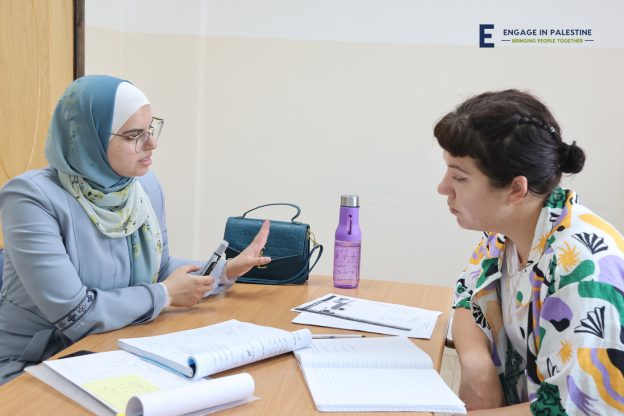Interesting Facts About Palestinian Arabic: Palestinian Arabic is the way people talk in Palestine. It’s not just one way of speaking, but many, depending on where you are in Palestine. It’s part of a big family of Arabic spoken in the region called Levantine Arabic (Shami dialect), which includes other countries like Jordan, Syria, and Lebanon. In this introduction, we’ll take a closer look at Palestinian Arabic—how it sounds, the words people use, and why it’s so important to Palestinian culture.
We’ll also explore how it’s influenced by history and how people are working to keep it alive for future generations. So, let’s dive in and discover the fascinating world of Palestinian Arabic! Here are some interesting facts about Palestinian Arabic:
1. Variety within Palestinian Arabic
Palestinian Arabic encompasses various dialects spoken by Palestinians across different regions, such as the West Bank, Gaza Strip, Palestinian refugees in Jordan, Syria, and Lebanon, and Palestinian communities in Israel. Each region may exhibit its own distinct pronunciation, vocabulary, and expressions.
| Native speakers | 13 Million Palestinians |
| Language family | Afro-Asiatic > Semitic |
| Dialects | Fellahi; Madani |
| Writing system | Arabic alphabet |
| Dialect varieties | Intelligible varieties of Levantine Arabic |
| Palestinian Alphabet | 28 letters |
2. Levantine Arabic Influence
Palestinian Arabic is akin to the Arabic spoken in Jordan, Syria, and Lebanon. Collectively, they form what we refer to as the Levantine Arabic family or Ammiya اللهجة العامية. Just as cousins often share similarities, Palestinian Arabic has many commonalities with these other dialects.
They have similar ways of saying words, grammar rules, and even some of the same words in their vocabulary. So, if you understand one of these dialects, you might find it easier to understand the others too! It’s like having a big language family that stretches across the region of levant, connecting people through their way of speaking.
3. Historical Influences
Palestinian Arabic has been influenced by various historical events and cultural interactions. It includes elements from ancient Semitic languages, Ottoman Turkish, English, and Hebrew, reflecting Palestine’s diverse history and cultural heritage.
4. Arabic Dialectal Diversity
Even within Palestine, there are different ways of speaking Palestinian Arabic. Imagine if you traveled from one city to another in Palestine—you might notice that people talk a bit differently in each place!
For instance, the way Palestinian people speak in Ramallah might have some differences compared to how they speak in Gaza City, Hebron or Nablus. These regional variations of Palestinian Arabic add even more richness and flavor to the Arabic language, showing how diverse and colorful Palestinian culture truly is.
5. Key Features
In Palestinian Arabic, you might notice some unique sounds and words that make it special. For example, the letter ق (qaf) might sound a bit different compared to other Arabic dialects—it’s pronounced with a deeper, throatier sound. Similarly, the letter غ (ghayn) has its own distinct pronunciation, giving Palestinian Arabic its own flavor.
When it comes to vocabulary, Palestinian Arabic is full of words and expressions that reflect Palestinian culture and daily life. For instance, you might hear terms related to traditional Palestinian foods like “mansaf” or “maqluba.” You might also come across expressions used in everyday conversations, such as “yalla” (let’s go) or “inshallah” (if God wills).
6. Influence of Modern Standard Arabic (MSA)
While Palestinian Arabic serves as the primary spoken language, Modern Standard Arabic (MSA) is employed in formal settings like education, media, and literature. Palestinians usually acquire MSA in school and employ it in formal written communication.
Palestinian Arabic has evolved to be the dialect closest to Modern Standard Arabic, with the variant spoken in the Gaza Strip serving as the primary example.
7. Cultural Significance
Palestinian Arabic isn’t just a way of talking—it’s a key part of what it means to be Palestinian. It’s woven into the fabric of Palestinian identity and culture, shaping how people express themselves and connect with their heritage.
Palestinian Arabic is present in every aspect of Palestinian life. It appears in poetry, capturing the beauty of the land and the struggles of the people. It’s heard in music, celebrating Palestinian resilience and resistance. In literature, it narrates the tales of past and present generations. Most importantly, in everyday interactions among Palestinians, language serves as a powerful tool for building community and preserving traditions.
8. Five Famous Words In Palestinian Arabic
In Palestinian Arabic, characterized by its rich cultural heritage, everyday conversations are enriched by common expressions like ‘yalla’ (let’s go), ‘inshallah’ (God willing), ‘salam’ (hello), ‘mabrook’ (congratulations), and ‘habibi’ (my dear), each carrying its own unique significance and reflecting the warmth and hospitality of Palestinian culture. These words are not just linguistic tools but also embody the spirit of connection, hope, celebration, and affection deeply ingrained in Palestinian society.
9. Essential Books for Learning Palestinian Arabic Dialect
You can use the same Levantine Arabic books to learn Palestinian Arabic; however, here are some of the most famous and beneficial books specifically tailored for studying the Palestinian dialect:
- Palestinian Colloquial Arabic Vocabulary” by Ahmed Younis
- Palestinian Colloquial Arabic: An Introduction to the Spoken Dialect” by Nasser Isleem
- Palestinian Arabic Verbs: Conjugation Tables and Grammar” by Matthew Aldrich and Ahmed Younis
In summary
Palestinian Arabic is a diverse and dynamic dialect that plays a pivotal role in Palestinian culture and identity. As a member of the broader Levantine Arabic family, which includes Jordanian, Lebanese, and Syrian Arabic, it shares linguistic features with other dialects in the region. Nevertheless, within Palestine, there are regional variations that contribute to the richness of the language.
Palestinian Arabic is characterized by its unique pronunciation, vocabulary, and grammar, including distinctive sounds for letters like ق (qaf) and غ (ghayn). It reflects Palestinian culture and daily life through specific words, expressions, and idioms.
Beyond just a means of communication, Palestinian Arabic plays a vital role in cultural expression. It is used in poetry, music, literature, and everyday interactions, serving as a symbol of Palestinian heritage and resilience. Through the preservation and celebration of Palestinian Arabic, Palestinians uphold their language as a source of pride and connection to their history and identity.
Related Posts
Find Us Online
Whatsapp:+972 599 479 880
Instagram: https://www.instagram.com/excellence.center
Facebook page: https://www.facebook.com/ExcellenceCenter
Facebook account: https://www.facebook.com/RafatECHebron
Watch us on Youtube: https://www.youtube.com/channel/UCsQSLdFZWZcBm6Uj0XMYuKg
Visit and Explore Palestine: https://www.facebook.com/ExplorePalestine
Tags: Grammar of Palestinian Arabic, Historical influences on Palestinian Arabic, Learn Palestinian Arabic, Linguistic characteristics of Palestinian Arabic, Palestinian Arabic course, Palestinian Arabic dialects, Palestinian Arabic expressions, Palestinian Arabic slang, Palestinian Arabic vocabulary, Palestinian colloquial Arabic, Study Palestinian dialect, Unique features of Palestinian Arabic



